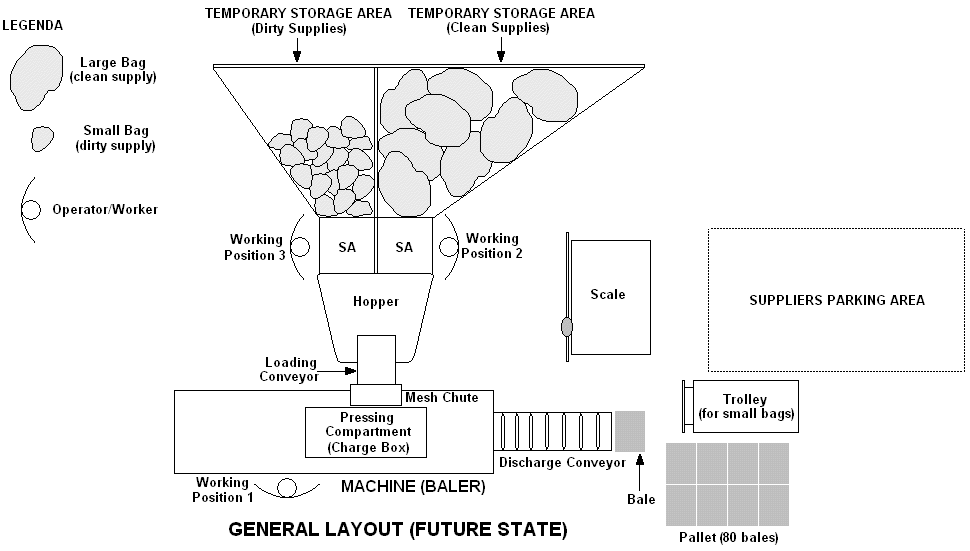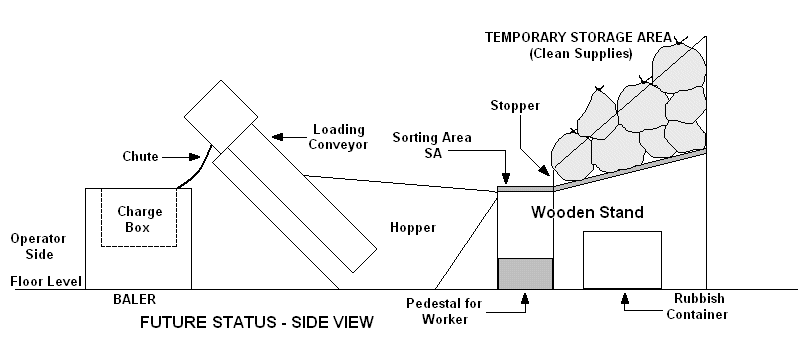|
navigation
consulting
services
training
services
specials
reading
material
resources
|
Analysis
The primary target in a case of this nature is to eliminate as much double-handling as possible.
In the present state, the supplied goods are handled:
- during the off-loading/weighing operation (necessary)
- when bags are thrown in the cans collection area (necessary, but can be organised differently)
- for sorting - in the can collection area (necessary, but can be streamlined)
- when loading the baler hopper (necessary, but can be streamlined)
A lean solution & conclusions must target at achieving a continuous as possible flow.
Hence the lean steps:
- Suppliers are very co-operative, and can be asked to position the off-loaded and weighted goods in "dedicated" areas - to the purpose the entire off-loading area has been re-designed.
- "Dedicated areas" means areas that can facilitate the achievement of a continuous style of flow. Since the most important operations in the process are "sorting" (when required) and "loading hopper", these dedicated areas should be as close as possible to the machine hopper. This will create the necessary conditions to establish the flow.
- Furthermore: the present sorting operation is messy and time consuming. This is due to the fact that sorting is done "in" the cans pile. This is very un-ergonomic: workers waste considerable time to stretch, bend, search for small "dirty" bags, open them up while standing, throw good cans in the pile and rubbish in the rubbish container, etc. The best way of sorting cans is at the correct working level, i.e. at hopper level (or just above it).
- At hopper level means +- 1,2 m. from the floor level: this is a very convenient height to work at ergonomically - possibly with workers standing on a pedestal - and on condition that a working area is created at that height.
- This leads to the idea of creating the "bags storage area" at that very same level: in this way, bags can be opened and sorted next to the hopper, and cans thrown in just by sliding them.
A plan and side view of the "future state area" are here below:


The main features of the future state are:
- The entire "storage-areas-before-processing" system has been re-designed, with "dedicated" areas for each of the non-ferrous materials (aluminium, copper A, copper B, stainless steel, and cans). Cans have a permanent storage area (see below), whereas all other non-ferrous materials are stored on trolleys (two for each type of material). Full trolleys are brought to the baler for pressing, on a rotation basis.
- With regard to scrap cans, two Temporary Storage Areas, respectively for clean and dirty supplies, have been provided on a wooden stand. The 2 storage areas floor is inclined, to allow descent of bags by gravity. Both storage areas have chipboard side walls (to prevent bags from falling) and a front "stopper".
- Between cans storage areas and hopper, two "sorting tables" have been provided: workers may comfortably do the sorting on these tables (possibly while standing on a small pedestal) and feed the hopper simply by "sliding" cans into the hopper.
- With the new layout, it becomes possible to re-engineer entirely the can processing operation. An analysis of the Takt Time reveals that on a 5-day operation Takt Time = 13 minutes per processed bale (@ 7 working hours per day = 420 minutes per day = 2100 minutes per week, the Takt Time is 2100/160 = 13,1 minutes per bale). But, on a 2-day in the week operation (as it is presently), the Takt Time becomes 840/160 = 5,25 minutes per bale. This means that if cans are processed continuously for 2 days, there are more than 5 minutes to get one bale out. (*)
- With an available cycle time (sort - load hopper - press and compact - hammer corners of bale - position bale on the pallet) of over 5 minutes, one worker alone can comfortably implement the whole processing operation. The new, ergonomic layout allows him to walk from machine to sorting tables - open clean bags and load the hopper - OR, open small bags, do the sorting, dispose of rubbish, and load the hopper - then start loading the machine pressing compartment (there is an operating button at the top of the loading conveyor) - then walk back to the machine front and operate the machine for pressing/compacting - then slide out the processed bale - then hammer its corners, and position it onto the pallet.
- Obviously things may be streamlined even further with an electro-hydraulic operation of the baler and duplicated commands next to the sorting tables. But this would help only marginally (it would just prevent some walking).
- While one worker processes cans, the other 2 take care of suppliers, off-loading goods, positioning, etc.
- Best results are achieved if the 3 workers are fully interchangeable (all of them trained to operate the baler).
- The cans processing operation does not need to be continuous (over 2 full days) - it can be done in lots of a few hours at a time - so that also other scrap materials may be baled every day, when required.
(*) TAKT TIME - REMARKS
The way the Takt Time principle has been adopted in this case is not the classical one. The definition of Takt Time is = customer demand/available time.
In this case the ratio supplier offer/available time has been used instead. Yet, its use is perfectly valid, since the Takt Time is what sets the speed and pace of production.
Read the case again - click here
Would you like to comment on this tutorial?
Would you like to suggest another solution & conclusions for this case?
Your comments and feed-back are most welcome - please contact Carlo Scodanibbio.
|



